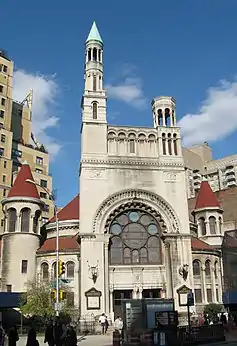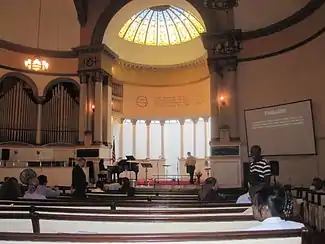First Baptist Church in the City of New York
The First Baptist Church in the City of New York is a Christian congregation based in a sanctuary built in 1890–93 at the intersection of Broadway and West 79th Street in the Upper West Side of Manhattan, New York City. The church is a conservative, independent, evangelistic, mission-oriented church in fellowship with the Southern Baptist Convention.[1]

Revolutionary years

The first attempt to establish a Baptist presence in New York City dates to 1711, when William Wightman began his ministry. A church was built on Gold Street but disbanded eight years later because of financial recession. Earlier attempts at forming a Baptist church in Flushing, Queens took place by William Wickenden and others in the 1650s.[2]
In 1745, Jeremiah Dodge settled in New York City, and began holding prayer meetings in his home. He was a member of the Fishkill Baptist Church. When he learned of Benjamin Miller at nearby Scotch Plains Baptist Church in Scotch Plains, New Jersey, he asked him to come and hold preaching services at the prayer meetings, which he did. Other ministers preached to this group from time to time, and in 1753, all thirteen of them joined the Scotch Plains Baptist Church after Miller had baptized some of them. They were organized as an independent Baptist church on June 19, 1762 by Benjamin Miller and John Gano – the latter being called as Pastor – and took the name "First Baptist Church in the City of New York". Gano served as pastor until 1776 when he became Chaplain in General Washington's American Army. The congregation's first sanctuary was at 35 Gold Street in Lower Manhattan, built in 1759–60.[3]
The church supported the American Revolution even though New York City was occupied by British forces from the summer of 1776 for the duration of the war. Elder Gano joined the army and was a chaplain to General George Washington. On his return to New York City after the revolution, Gano found thirty-seven members who restored the church building and grew thereafter to two hundred. When the Congress offered former revolutionary soldiers land on the frontier, Gano departed from New York to Kentucky. There he started several Baptist churches. He was also a founder of the Baptist-affiliated Brown University in Providence, Rhode Island.
Early 19th century
From 1801–02, the First Baptist Church built a new stone structure at its site on Gold Street.[3] During the period they were located there, the congregation's "inhospitality" to African-Americans provoked the founding of the Abyssinian Baptist Church.[3]
Under the leadership of Dr. Spencer Cone, the congregation relocated in 1842 to a Gothic revival structure at 354 Broome Street at the intersection of Elizabeth Street.[3] This was also the headquarters of the Baptist Home and Foreign Mission Board. This sanctuary is still in use today by the Evangelical Lutheran Church of St. Matthew.[3]
When the congregation outgrew the facility, it moved further uptown to the intersection of East 39th Street and Fourth Avenue.[4] Under the leadership of Dr. Thomas Anderson, a Gothic brownstone sanctuary was constructed, as well as a separate Bible school building.

Sanctuary at Broadway and 79th Street
The First Baptist Church relocated to the present facility in 1890. It occupies a site that, because of a bend in the direction of Broadway, is prominent from a distance down the avenue. The building is set at an angle of 45 degrees to the street grid.[3]
The building was designed by George M. Keister, who 25 years later designed the Apollo Theater in Harlem.[3] A balcony was added in 1903. This created a seating capacity of one thousand. Two unequal towers over the corner entrance to the main auditorium are examples of Biblical symbolism. The taller tower represents Jesus Christ as the Head of the Church. The lower tower, which appears incomplete, was designed to represent the Church, which will remain unfulfilled until the return of Christ.[3] Two shorter towers represent the Old Testament and the New Testament.
A large rose window facing Broadway pictures Christ as the center of the New Testament church. He is in the large inner circle. The star depicts Him as the Bright and Morning Star. The crown shows Him as King of Kings. The frame of sun portrays Him as the Sun of Righteousness. The five upper circles depict the writers of the New Testament Epistles, while the bottom four circles represent Matthew, Mark, Luke, and John, the Gospel authors.
In the sanctuary, the Hebrew text is the essence of Genesis 1:1, "In the beginning, God..." The Greek text is the essence of John 1:1, "In the beginning was the Word (Jesus Christ)." In the upper right are the Greek symbols of Alpha and Omega, the first and last letters of the Greek alphabet. Jesus refers to Himself as the Alpha and Omega in Revelation 1:8 and 22:13. In the upper left are the Greek characters pi and chi. This may stand for Pater and Christos, Father and Christ.
In the church's Gano Chapel are paintings of Gano's baptizing Washington and of Gano's praying in thanksgiving for the British surrender. They are copies of originals located at William Jewell College in Liberty, Missouri. The college collection includes Gano's sword, which was a gift from General Washington, who had received it from the French General Marquis de Lafayette.
Pastors since 1884
First Baptist Church has had eighteen pastors, two of whom were chaplains of the United States Congress. Two were also college presidents. Two founded colleges. Collectively, the pastors have written more than three hundred books, mostly on the Christian religion. Many have been denominational leaders. The church was led by a number of interim ministers during years without a pastor.
Isaac Massey Haldeman was the pastor who thus far has served the longest tenure at First Baptist Church – from 1884 to 1933.
|
|
References
Notes
- http://mnyba.org/about/mnyba-churches/
- Newman, Albert Henry. A history of the Baptist churches in the United States, v.2 of American church history series (6th ed.) C. Scribner's Sons, 1915. p.233
- Dunlap, David W. (2004). From Abyssinian to Zion: A Guide to Manhattan's Houses of Worship. New York: Columbia University Press. ISBN 0-231-12543-7., p.73
- Fourth Avenue above 32nd Street was later renamed Park Avenue.
Bibliography
- First Baptist Church. "The History and Architectural Symbolism of The First Baptist Church in the City of New York, 79th at Broadway" (brochure)
- Haldeman, Isaac Massey. Ten Sermons on the Second Coming of Our Lord Jesus Christ Fleming H. Revell Company, 1916.
- Mindlin, Alex. "With Bowed Heads, A Flock Looks Warily Ahead" The New York Times (October 29, 2006)